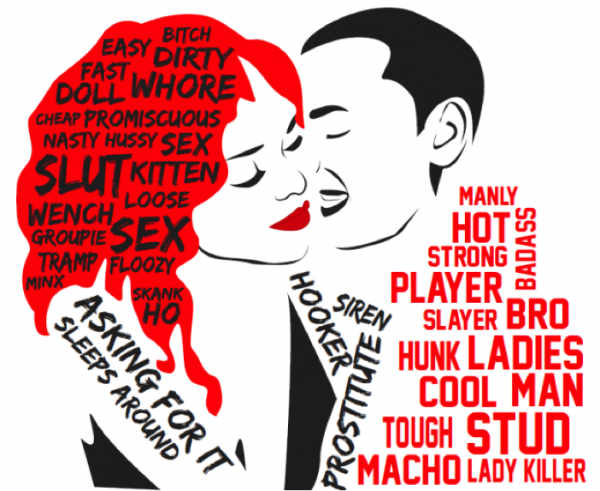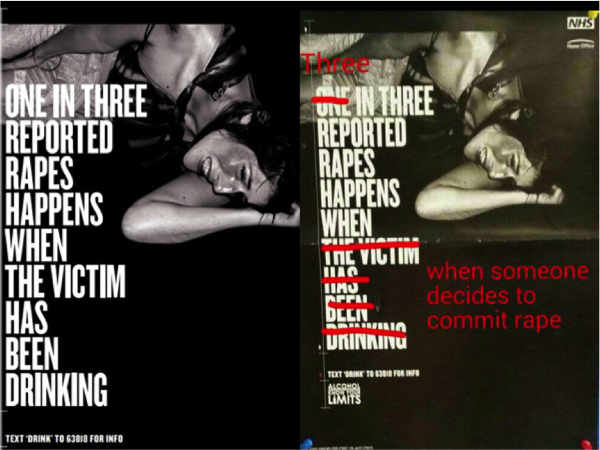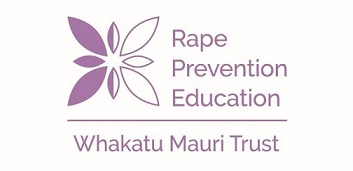Rape Culture
DEFINITION
Rape culture exists in a society or environment in which common social beliefs, attitudes and morals normalise sexual violence, encourage people to associate sex with violence, and minimise the seriousness of sexual violence (Wright, 2015). Within rape culture, sexual violence is accepted, justified and not challenged enough by society (Field, 2004).
The number of sexual assaults is high but the rates of convictions of perpetrators are low and excuses are often made to justify why people commit sexual violence (Field, 2004). Rape jokes are common, the word “rape” gets casually thrown into conversations to describe things other than sex without consent (“Did you see the game last night? We totally RAPED them!”), and people are told “don’t get raped” more often than people are told “don’t rape.”
IMPACTS
The impacts of rape culture are negative. Within rape culture, women especially are made to feel as though it is their responsibility to avoid being sexually assaulted and police their behaviour as a result (Wright, 2015). For example, women may choose to avoid wearing certain clothing, drinking alcohol, or walking home alone at night. Survivors are often blamed for the sexual assault instead of the perpetrator (Field, 2004), even though it is always the fault of the person doing the harmful sexual behaviour.
Rape culture also enforces the unhelpful belief that men cannot be victims of sexual violence. Because of this, survivors are less likely to report their assaults because they are afraid of not being believed. This can slow down the healing process and the perpetrator is not held responsible for their crime.

MEDIA & PORNOGRAPHY
The media (newspapers, TV, movies, social media, etc) plays an important role within rape culture. It can desensitise people to the seriousness of sexual violence, sexualises and objectifies female bodies, and often sympathises with perpetrators instead of survivors.
Pornography also plays a big role in rape culture. Within porn, sex and violence are interconnected which can train people to be aroused by violent sex (Field, 2004). This sends the incorrect message to the viewer that this is what ‘normal sex’ looks like. A lot of porn is explicitly ‘rape porn’ which portrays the incorrect message that people enjoy rape and that sexual violence is normal.
RAPE MYTHS
Myth #1
“Rape/sexual violence is something only done by a stranger in a dark alley.”
Busted! We know that almost all (92%) of survivors know or can identify the perpetrator(s) (Kingi & Jordan, 2009).
Myth #2
“Rape/sexual violence is a one-off traumatic event.”
Busted! Kingi & Jordan (2009) found in their study that only 11 out of 75 survivors had experienced a single incident of sexual violence as an adult, whereas 85% of survivors reported being sexually assaulted more than once.
Myth #3
“Survivors will always report sexual violence to the police.”
Busted! Reporting of sexual violence in Aotearoa New Zealand is very low, with only an estimated 9% of incidents ever reported to police (Ministry of Women’s Affairs, 2009).
There are many understandable reasons why survivors don’t report and it is totally up to them if they want to or not. Reasons may include:
Fear of not being believed, fear of the effect it on their family, feelings of shame fear of the offender, blaming themselves, the nature of the relationship with the offender, fear or not trusting the legal system, don’t think or know that sexual violence is a crime.
Myth #4
“False complaints are common.”
Busted! The majority of sexual violence claims are true. Research has shown that approximately only 8% of rape allegations are false (Ministry of Women’s Affairs, 2009). If we believe someone when they confide in us, they are much more likely to get the help they need. This is why it is incredibly important to believe someone if they tell you they have been sexually assaulted.
Myth #5
“Being intoxicated, flirting, wearing a short skirt or dress, and/or walking alone at night is an invitation to be sexually assaulted.”
Busted! Nothing is an invitation to be sexually assaulted. People have the right to drink alcohol, be flirty, wear whatever they want, walk alone at night—and still be safe. It is ALWAYS the fault of the person doing the harmful sexual behaviour and NEVER the survivor’s.
Myth #6
“Sexual violence only happens to women.”
Busted: Although most sexual violence happens to women (one in five by the age of 16), one in ten males will also be sexually assaulted by their 16th birthday (Clark, 2015) and one in two transgender individuals will be sexually assaulted at some point in their lives (Forge, 2005).
VICTIM BLAMING
Part of rape culture is victim blaming - victim blaming is when the actions or movements of the victim/survivor are blamed for the sexual assault instead of the perpetrator.
Watch the video here to see what it would be like if reporting a robbery was like reporting a rape

WHAT CAN WE DO?
What can we do about rape culture?
- Consent education in schools and alternative education spaces (like BodySafe and Mates & Dates!)
- Calling people out when they make rape jokes or use the word ‘rape’ to describe anything other than sex without consent - don’t let these comments and jokes slide!
- Be aware of the negative impacts pornography can have.
REFERENCES
Affairs, M. o. (2009). Restoring Soul: Effective Interventions for Adult Victims/Survivors of Sexual Violence. Wellington: MWA.
Eyes, C. (2015). Pornography Statistics. n/a: Covenant Eyes, Inc.
Field, R. (2004). Rape Culture. In M. Smith, Encyclopedia of Rape (pp. 174-175). Westport, CT: Greenwood Press.
Forge. (2005). Sexual Violence in the Transgender Community Survey. International Journal of Transgenderism, Philadelphia.
Kingi, V., & Jordan, J. (2009). Responding to Sexual Violence: Pathways to Recovery. Wellington: Ministry of Women's Affairs.
Kingi, V., & Jordan, J. (2009b). Responding to Sexual Violence: Attrition in the New Zealand Criminal Justice System. Wellington: Ministry of Women's Affairs.
Kingi, V., & Jordan, J. (2009c). Responding to Sexual Violence: An Environmental Scan of New Zealand Agencies. Wellington: Ministry of Women's Affairs.
Wright, S. (2015). Sexual Violence, CRIM 212 Lecture. Victoria University of Wellington.
